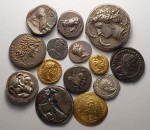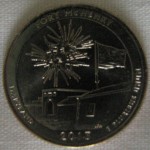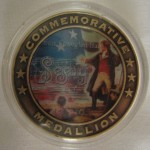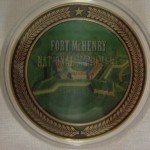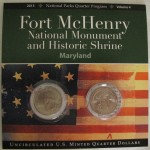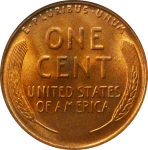Before Saint-Gaudens would finish, he died of cancer in 1907.
Roosevelt still wanted to redesign the cent but did not have any ideas. In 1908, Roosevelt was posing for a Panama Canal service medal that was being designed by Victor David Brenner. Brenner, an immigrant who admired Abraham Lincoln, suggested that he design a coin honoring Lincoln to coincide with the centennial of Lincoln’s birthday in 1909. Roosevelt asked for samples and agreed to Brenner’s design proposal.
Brenner designed the reverse of the with two ears of durum wheat, one the most prolific wheat grown in the United States today. Wheat is the United States’ most successful crop and largest agricultural export.
Not only is it a successful crop, but over the 50 years in production, the U.S. Mint has produced a lot of its own wheat with every cent it made.
If you think about it, all that wheat could make a lot of bread.
If 25.98 billion wheat cents yields 2.494 million bushels of wheat where each bushel yields 66 loaves of bread, if the U.S. Mint all the wheat struck on every Lincoln cent between 1909 and 1958 would have produced 164,609,280 loaves of bread.
If a bushel of wheat makes 42 pounds of pasta, which is about 210 servings of spaghetti, 2.494 million bushels of wheat would have produced 104,748,000 or 523,740,000 servings of spaghetti.
Credits
- The idea for this post came from Montgomery County Coin Club Treasurer Jack Schadegg during a talk at our recent coin club meeting.
- Various sources were used to calculate and verify the production of Lincoln cents from 1909 though 1958.
- The National Association of Wheat Growers’ website provided the capacity figure.
- Lincoln cent wheat ears reverse image courtesy of Wikipedia.
Sep 11, 2013 | coins, commemorative, commentary, personal
Twelve years ago, I was a few miles away from the Pentagon when a plane crashed into its side. I remember driving to work hearing about the plan crashes in New York originally thinking that what I predicted many years ago finally came true, a small plane crashed into the World Trade Center. The reports turned grim as I kept driving toward my office.
When I arrived, I sat in the car a while listening to the radio and trying to call friends I knew who worked in lower Manhattan. I remember one was working in the World Financial Center across the street from the Twin Towers. I later found out that he had taken a job on the other side of the river in New Jersey a year earlier.
Another friend was working in 6 WTC, a 40 story building next to 2 WTC or Tower 2. Thankfully, he and his coworkers were able to escape before the second tower collapsed onto that building.
Just after the plane crashed into the Pentagon we were sent home.
I came home to the empty house my late first wife and I bought. She had died five months earlier and this time, the quiet of the house was deafening. I tuned on the television just before the second tower collapsed.
Although it was twelve years ago, I remember the day like it happened yesterday. Those who were around when President Kennedy was assassinated say the same thing about that day. It is difficult to forget these traumatic events, which is good. We should not only remember them but remember what happened after in order to do better next time. We need to learn from history rather than repeat it.
-
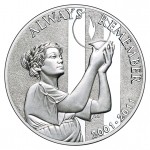
-
September 11 National Medal obverse features Lady Liberty holding the Lamp of Remembrance. Behind her are beacons of light stretching skyward. Liberty, the lamp and the light symbolize not just the immeasurable loss on that fateful day, but also the resiliency and triumph of those who persevered. The inscriptions are ALWAYS REMEMBER and 2001–2011.
Designer: Donna Weaver
Engraver: Phebe Hemphill
-
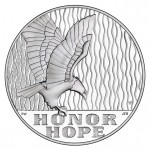
-
September 11 National Medal reverse depicts an eagle, symbolizing the strength of the survivors, families and Nation, against a backdrop of cascading water. The flowing water is emblematic of peace, serenity, healing and the continuity of life. The inscriptions are HONOR and HOPE.
Designer: Donna Weaver
Engraver: Joseph Menna
Medal images and descriptions courtesy of the U.S. Mint.
Sep 10, 2013 | administrative, coins
Although many of us have agreed to speak in a common language, communities tend to take the language and mold it to make it unique to their situation. It is the most evident in the differences between terms we use here in the United States versus those used in Great Britain. Just look at your car and know that the compartment that contains the engine is under the hood here in the United States while the engine is in the bonnet in England. As George Bernard Shaw is credited with saying, “England and America are two countries separated by a common language.”
Numismatics is no different. Tell a numismatist that a coin is in good condition and the novice does not understand why the numismatist is no longer interested in the coin. Depending on the coin, a fine coin does not excite either.
What does it mean?
What is a a “bourse?”
Or to say a coins has been plugged?
What is “mint state?”
Now you have a place to look up the words. Under the tab, “Collector’s Reference” at the top of this page there is a new submenu titled Numismatic Glossary. The Coinblog’s Numismatic Glossary is the result of a one year collection of numismatic terms and the attempt to write good (or just decent) definitions of those terms.
I am publishing the Numismatic Glossary is a resource to the numismatic community. While I tried to be as accurate as possible, it is possible that I made a mistake. It is also possible that I left something out. If you have a correction or a request for me to add a term, please drop me a note and let me know.
EDITED TO ADD: I also updated the U.S. Coins by Type page to include the 2013 American Buffalo reverse proof coin.
Happy Collecting!
Sep 6, 2013 | coins, commemorative, legislative, policy, US Mint
H.R. 2932: United States Coast Guard Commemorative Coin Act
Sponsor: Rep. Joe Courtney (D-CT)
• To require the Secretary of the Treasury to mint coins in commemoration of the United States Coast Guard.
• Introduced: August 1, 2013
• Referred to the House Committee on Financial Services
Track this bill at http://www.govtrack.us/congress/bills/113/hr2932
Sep 4, 2013 | administrative, Israel, medals
To all my Jewish readers,
L’shanah tovah tikatev v’taihatem
May you be inscribed and sealed for a good year
This is the earliest that Rosh Hashanah has appeared on the Gregorian Calendar since 1899. Later this year, Chanukah and Thanksgiving will occur on the same day for the first time in history. With the nuances of the calendars, this will not happen again for 77,789 years.
It will be 5774 on the Jewish calendar which is a leap year. Since the Jewish calendar is lunisolar, a calendar whose date indicates both the moon phase and the time of the solar year, a leap year adds one month to the calendar. Adar I will begin on February 1 and last for 29 days. All Adar holidays, such as Purim, occur in Adar II.
A Happy and Healthy New Year to you and your family!
Sep 3, 2013 | books, cents, coins, review
Rosie was not just a riveter during World War II but she also worked at the U.S. Mint in Philadelphia making blanks for coins.
Working in the blanking room at the U.S. Mint was not an easy job. It was hot, loud, and Rosie was confused. Even though she was supposed to feed a sheet of zinc coated steel into the blanking press, Rosie fed a sheet of copper. With the press of a button, 40 copper blanks were made.
Rosie panicked. The president ordered that the U.S. Mint not use the copper for coins so it could be used for the war effort. Not knowing what to do, Rosie let the coins proceed to the next stations where they were washed and “pinched” to create rims keeping her fingers crossed that nobody found out.
The copper blanks were fed into the press along with the zinc-coated steel blanks and thus was born Penny, a 1943 copper cent.
The Wishful Penny is the story of Penny’s adventure from her accidental birth, to an ice cream shop, across the Atlantic, back again, and how one wish made on Penny comes true.
Written for readers in grades 3-5 with a story that can be appreciated by younger students, The Wishful Penny written by J.J. (Jennifer Jo) Young, co-founder of the publisher See the Wish, surrounds the story of a wish made on a penny as it is thrown into a fountain with factual information about the coin and conditions. The story opens with the book’s Rosie, a name obviously chosen, who never worked before but was thrown into working at the U.S. Mint in Philadelphia because the men were off at war. It mentions that President Roosevelt order that copper be preserved for the war effort and even approaches the angst of the time with relative off at war and businesses hoping for survival in difficult times.
The use of factual information makes the story more appealing. Forget the fact that I am some-number-of-many-years beyond the target age group for this book, it has the ability to not only teach the students but also the teachers who may have not thought about using coins as a teaching tool. If a teacher wants to use this book for classroom instruction, the authors offer a teacher’s kit that includes books, worksheets, discussion questions, activities, history tie-ins, and script with a CD of music to allow the students to perform the book as a play.
Aside from the history, the book teaches about real world perseverance from the perspective of Penny, whose optimism about carrying her wish is a good lesson for all children. While having optimism is good, the book also teaches how there is a long road to fulfilling goals that comes with the bumpy road of life. As someone who grew up with parents who wanted me to skin my knees because learning not to was as important as losing the game in order to understand life is just not handed to you, the book portrays that as a series of disappointments. With optimism in tact, Penny goes from the fountain where she meets the silver coins, to Ireland where she lives in a safe with other coins, to running away from thieves, and helping catch them before being mailed back to the United States and finding that a coin is different from the stamps that make the journey with her.
If you buy the book individually, it will come with a CD with 12 songs interspersed with acted audio scenes from the book. It is not exactly faithful to the dialog in the book, but your youngster may not mind. Remember, that the music is intended for your children and that an adult may request their child listen with headphones. After growing up with Peter, Paul and Mary, I am not sure I would have ever like the music. Since I am not the target audience I am not going to complain! However, the audio CD could be just the thing to keep your child busy for an hour during a long drive.
You can also buy the book as an audio CD. The audio book is read by January M. Akselrad, the other co-founder of See the Wish. Ms. Akselrad reads the book just like you would expect to a younger audience. However, I found myself re-reading the book along with her thinking that this might be good for a student who may have a difficult time reading to follow along while listening to the book being read for them.
Although I am not a teacher, I can see using the audio CD with the books in order to show visual highlights of story but the history it shows. Since I was not provided the teaching materials, I can only hope the authors provide teachers with this information.
Coins can teach us a lot about history and history can teach us a lot about ourselves. Although the exact reason for the existence of the copper 1943 cents can only be speculated, turning it into a story for children works on so many levels. I even like that the person who found Penny only to realize she was special was a girl learning about collecting coins. Add to that the collector who buys the coin was a woman is also a lesson that this should not be a male-dominated hobby!
I did not know what to expect when I agreed to review this book. But I was surprised how engaging it was even for a “vintage” person like me. Even though Penny ends up at less than an Mint State (MS) grade by the end of the book, I grade this book MS68 with a recommendation that if your young reader does have reading difficulties also purchase the audio CD. In fact, you may want to consider purchasing the teacher’s kit and donate it to your child’s school. Or for the classes looking to put on a play, why not consider the full-length musical with recorded music. It has to be a great idea for teachers needing new material!
POST SCRIPT FOR PARENTS: After your child reads the book and she wants more information about coins and collecting, let them vista the U.S. Mint h.i.p. pocket change website. “H.I.P.” stands for History In your Pocket, which best describes how many of us see coins.
POST SCRIPT FOR TEACHERS: After your class read this book and performs the play, I would recommend teachers visit the U.S. Mint teacher’s website for additional resources to using coins in the classroom. Who knows, maybe we can turn you and your students into numismatists!
Disclaimer
A copy of the book and audio CD was provided by the author in exchange for this review. Even as I type this, the author does not know what I will say. However, I did inform her I will be donating the audio CD to the county library to be placed in an area where the children need the most help.
Apology
I want to take this opportunity to apologize to the author for taking so long to do this review. She was prompt in sending the book and I should have made the time to reward her promptness with a timely review. I appreciate her patience.
Sep 1, 2013 | ANA, books, charity, coins, education, personal, review
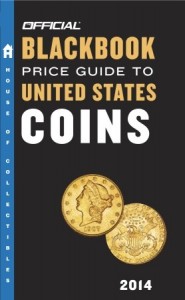 Last year I reviewed The Official 2013 Blackbook Price Guide to United States Coins I received as an e-book from the publisher. In that review I was surprised as to the quality information that was in the book including articles that were written by numismatists sharing their expertise with the collecting public. Unfortunately, some of the information seemed dated and needed updating. Apparently the editors agreed and worked to update information.
Last year I reviewed The Official 2013 Blackbook Price Guide to United States Coins I received as an e-book from the publisher. In that review I was surprised as to the quality information that was in the book including articles that were written by numismatists sharing their expertise with the collecting public. Unfortunately, some of the information seemed dated and needed updating. Apparently the editors agreed and worked to update information.
Based on the review, the editors turned to a numismatist whose experience with computers, the Internet, and writing for the collector who could add the information about using technology to enhance the collecting experience.
This is where your favorite blogger enters the picture.
The Official 2014 Blackbook Price Guide to United States Coins has an new chapter, “Using Technology to Enhance Your Collecting Experience.” Written in plain language for the collector, the chapter discusses what numismatic-related resources are online.
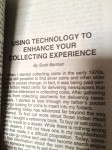 The chapter opens with a brief history of how computers and the Internet has advanced my collecting experiences. This includes a brief history of the Internet from its birth as ARPAnet through the invention of the birth of the World Wide Web and the services we now take for granted. I wrote it so that when you hear something Internet and web history in the news you have the background to understand why it is important.
The chapter opens with a brief history of how computers and the Internet has advanced my collecting experiences. This includes a brief history of the Internet from its birth as ARPAnet through the invention of the birth of the World Wide Web and the services we now take for granted. I wrote it so that when you hear something Internet and web history in the news you have the background to understand why it is important.
Following the introduction are sections that helps you find the information you want online. These sections are titled:
- Online Price Guides
- News and Blogs
- Mobile Computing
- E-books
- Social Media
- Buying and Selling Online
- Auctions (Established auction houses and their online options)
- Looking into the Future
- Your Security Online
If nothing else, the section “Your Security Online” may be worth the price of the book. It is something I have written in many forms, in many places, and have lectured about locally. These are general awareness tips that everyone should follow.
To their credit, the editors Mark Hudgeons, Tom Hudgeons Jr., and Tom Hudgeons Sr. read my review and updated the 52nd Edition of The Blackbook to address many of my concerns outside of my chapter. It is a better reference than in the past and worthy of a place in your numismatic library!
Autographs For Education
After autographing my first copy of the book I decided that rather than give away my autograph I want to use it to help raise money for numismatic education. For every autograph, I am asking for a minimum donation of $25 to the American Numismatic Association Florence Schook School of Numismatics to be used to further all numismatic education.
You can either mail the check yourself to the ANA and show me that you donated or give me the check and I will mail all of them together. Checks given to me should be made payable to the “American Numismatic Association” (NOT ME!) with a note on the memo line saying “For The Florence Schook School of Numismatics.”
For your donation, I will autograph the first page of my article above the title and give you recognition here on the blog. Since the ANA is a not-for-profit organization, your donations are tax deductible to maximum allowed by law.
One way to find out where I will be is to follow me here on the blog since I usually announce when I am going to a show. For planning purposes, I will attend the Virginia Numismatic Association Show on Saturday, September 28; the Pennsylvania Association of Numismatists show during October 24-26 (my attendance dates TBD) in Monroeville (a suburb of Pittsburgh); and the Whitman Baltimore Expo on Saturday, November 9. I might attend the Wall Street Coin, Currency and Collectibles Show in October if I can resolve a scheduling conflict.
Of course scheduling conflicts do arise, but let me know you if you will be looking for me at a show.
Post Script
Collectors of paper money, world coins, and stamps will be happy to know that the chapter will be adopted for the Blackbook covering those areas in 2015. I will also update the the current chapter since the online world has changed a little since it was written (e.g., Google shutdown the Reader service).
Book cover image courtesy of Random House.
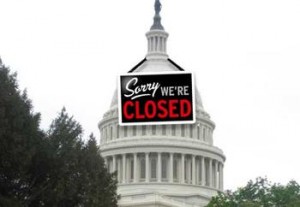 In the ongoing drama that is United States Federal government, a shutdown is looming over the shear idiocy of idiot-loges on both sides of the aisle attempting the rule and not govern. All 537 politicians elected to federal office are in need of a good spanking.
In the ongoing drama that is United States Federal government, a shutdown is looming over the shear idiocy of idiot-loges on both sides of the aisle attempting the rule and not govern. All 537 politicians elected to federal office are in need of a good spanking.